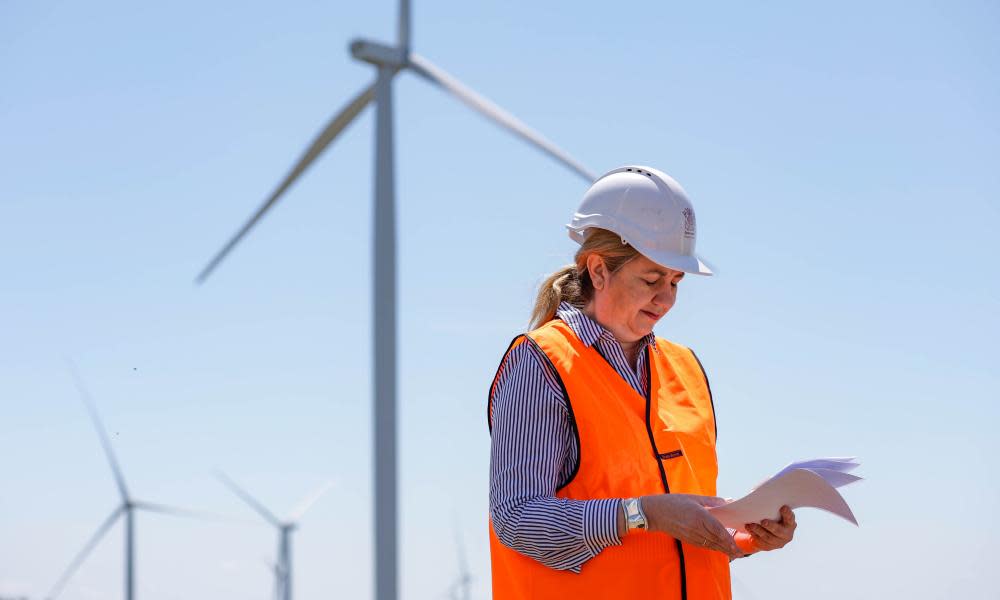Queensland’s renewable energy plan confirms the politics of coal have changed for good

The mayor of Mackay, Greg Williamson, wasn’t convinced by renewable energy.
About four years ago, I asked him about the energy transition; specifically, whether mining hubs like Mackay should start planning early to prevent the sort of economic shocks that would come as fossil fuel industries decline.
“Well, mate, hang on,” he said.
Williamson supported building a new coal-fired power station. He said solar was unreliable at night; that renewables provided only a small percentage of the state’s power grid.
“The industry has got a lot to prove yet.”
On Thursday, Williamson stood on the shop floor of a Mackay steelworks and said green energy would be “the future saver, the job protection” for regional Queensland.
This sort of scene was unimaginable four years ago; even 18 months ago. Williamson looking on approvingly as the premier, Annastacia Palaszczuk, sold a (relatively) ambitious plan to curtail coal-fired power stations.
To do so in Mackay, the regional hub for Queensland’s coal country, and in front of a group of enthusiastic blokes in hi-vis, seemed surreal.
Finally, the reality of Queensland energy politics has become connected to reality.
In the bad old days of 2021, even talking about planning for the energy transition would provoke a fierce reaction from a cabal of deniers – from newspaper columnists to politicians – who could effectively stoke fear about job losses in the regions.
Related: Queensland government pledges to end reliance on coal-fired power by 2035
Remember when the chief executive of the Stanwell Corporation, Richard van Breda, resigned a few days after giving a speech flagging the need (due to changes in the energy market) to curtail coal-fired power stations?
Such was the sensitivity of the issue then that the energy minister, Mick de Brenni, had to release a statement confirming bluntly that coal generators would not close early.
Oh how things have changed!
There are some, still, attempting to shout down Queensland’s plan to reach 80% renewables by 2035. But the difference now is that most of us, including the state government, are no longer listening. Fringe voices have been relegated where they belong, to the fringe of debate.
The obvious political explanation is the Green-teal success at the 2022 election, but there is something else going on here too. It’s been happening in places such as Gladstone, where people like Dr Amanda Cahill have been working on the ground to reframe the conversation around energy transition.
Regional people now see economic opportunity where once there was only fear of job losses. People like Williamson see opportunity for cane growers to double production by embracing plans to use sugar as a feedstock for bio-energy and bio-manufacturing, where investors demand green energy.
Sure, for some the idea remains scary. Many are still sceptical. But most now realise that it’s better to have a government with a plan; one that is no longer scared to even use the word “transition” for fear of provoking outrage.
The most critical element of the Queensland government’s plan is its jobs guarantee for energy workers. One will eventually be needed for coalminers too.
The success of the complete transition away from coal (and ultimately gas) is underpinned by a couple of bets. They are educated bets, but it’s clear there’s a degree of risk involved.
The first is the promise of green hydrogen. The Queensland government has spent a lot of time recently speaking about how hydrogen would underpin new-economy jobs in industrial hubs such as Gladstone and Townsville. It is also building a new gas peaking power station at Kogan Creek, in the Darling Downs, which would notionally be run using hydrogen.
At the same time, questions are emerging about cost and the future viability of hydrogen as a power source. To be clear, these are not reasons why any government should avoid laying the groundwork for a potential future industry worth billions, particularly in exports. But there are reasons to be, at the very least, cautious in our optimism.
The second leap of faith taken by the Queensland government is what the premier describes as the “centrepiece” of the energy plan – to build the world’s biggest pumped hydroelectricity scheme: “The battery of the north”.
The Pioneer-Burdekin pumped hydro is needed to meet Queensland’s ambition to stop burning coal, but the project remains in very preliminary stages.
Some detailed work has been undertaken and there is a lot of confidence within government about the viability of the site. But these things take time for a reason. Geotechnical and environmental studies still have to be done. Homes have to be resumed. Traditional owners have to be consulted and give their approval.
These things present potential pitfalls.
Halfway through the government’s press release on Thursday was an interesting qualification: “Queensland Hydro will also continue to investigate large-scale, long-duration pumped hydro sites in the event the project is unable to proceed.”
If things can change so dramatically in the past year, imagine what might happen in the decade before the Pioneer-Burdekin is built?
The Queensland government was not on track to meet its existing target of having 50% of electricity generated by renewables by 2030. Lifting that ambition, to 70% by 2032, is reason for optimism. But matching ambition with action – navigating the challenges and pitfalls of the next decade to stay the course – is the part that actually matters.

 Yahoo News
Yahoo News 
